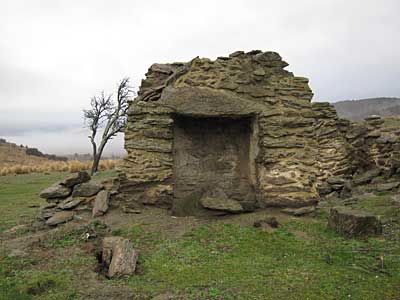A new look at New Zealand's Bendigo
For the last couple of weeks I've been going through some challenging yoga sessions and so this weekend feeling quite tired I opted to stay at home, do some work, and like last Sunday head out pre dawn to make some landscape photos.
First light found me at the historic Bendigo gold mining area, just 20 mins. from home, on the lower Dunstan Mountains. Although I go there often, today I was lucky to find some new areas to fossic amongst...

I presume it got it's name from it's Australian counterpart, but it was actually made up of two towns at least: Welshtown and the lower altitude Logantown. We'd had very heavy rain overnight and I've never seen this area, known as the driest in New Zealand, so wet...

It's not good for the normally dry walls to get this damp. Without a roof and eves they would not last long in a less dry climate...

The Bendigo gold mining area is just riddled with mine shafts. Some are so deep it takes ages to hear a dropped stone land at the bottom. However some are more horizontal, or follow a natural feature like this very deep crack which has been throughly exploited mining wise, and now overgrown...

I wonder what this fancy building, with the steps beyond, was for? It overlooks the Matilda stamping battery site [long gone, but the foundations and stonework to support these huge structures is still there]...
A tipping dray at Logantown - I suspect it's a relic of more recent farming days, than left over from the 1860s...

This small flat area was the site of Logantown, which was developed in 1869.
It was simply an irregular line of corrugated iron buildings, with seven hotels, four general stores, two butchers, a bakery, a drapery and a Temperance restaurant. Most of these businesses were gone by 1872
The mine manager's house at Logantown...

This little cottage, still lived in, is lower down near the Cromwell/Tarras road - history of a later flavour really. Today it's all about grapes..

First light found me at the historic Bendigo gold mining area, just 20 mins. from home, on the lower Dunstan Mountains. Although I go there often, today I was lucky to find some new areas to fossic amongst...

I presume it got it's name from it's Australian counterpart, but it was actually made up of two towns at least: Welshtown and the lower altitude Logantown. We'd had very heavy rain overnight and I've never seen this area, known as the driest in New Zealand, so wet...

It's not good for the normally dry walls to get this damp. Without a roof and eves they would not last long in a less dry climate...

The Bendigo gold mining area is just riddled with mine shafts. Some are so deep it takes ages to hear a dropped stone land at the bottom. However some are more horizontal, or follow a natural feature like this very deep crack which has been throughly exploited mining wise, and now overgrown...

I wonder what this fancy building, with the steps beyond, was for? It overlooks the Matilda stamping battery site [long gone, but the foundations and stonework to support these huge structures is still there]...

A tipping dray at Logantown - I suspect it's a relic of more recent farming days, than left over from the 1860s...

This small flat area was the site of Logantown, which was developed in 1869.
It was simply an irregular line of corrugated iron buildings, with seven hotels, four general stores, two butchers, a bakery, a drapery and a Temperance restaurant. Most of these businesses were gone by 1872
The mine manager's house at Logantown...

This little cottage, still lived in, is lower down near the Cromwell/Tarras road - history of a later flavour really. Today it's all about grapes..

Labels: Bendigo, Dunstan Mountains, gold mining












